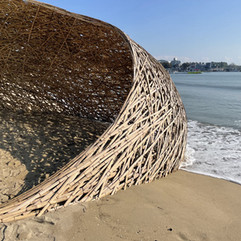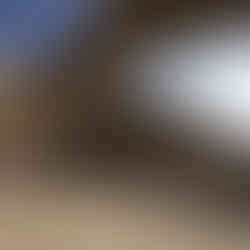孕育 / Gestate
- Lee, Kuei-Chih

- 2021年10月25日
- 讀畢需時 3 分鐘
已更新:2024年2月27日




Photos: Busan Biennale Organizing Committee
Ⓒ PARK Hongsoon
作品名稱:孕育
創作者:李蕢至
媒材:竹子
尺寸: 20m(L)x 6m(W)x 3.4m(H)
地點:韓國釜山日光海灘
年代:2021
2021海洋藝術節
釜山雙年展組委會
由於COVID-19病毒在世界大流行,各國為了防堵疫情而採取了相對應的措施,而這也導致地球上人類活動大幅度地減少。在人類活動減少之後,我們發現地球的生態比以前更加清潔和平衡。這也使得人類得更加認真地思考人與自然之間的平衡關係與需索問題。
此波浪形的自然雕塑位於南韓的日光海灘它在沙地上佔據了一部分低潮和高潮之間的空間,伴隨著潮水的漲退呼吸的同時,也與海浪相融共生。此外,竹子在柔美的線條下有著山的屬性與特質。我在海邊使用竹子創造這件「海的氣息」作品,試圖連接著山與海、人與自然,擁抱這大自然的流動能量,將人類創作的禮物送給這片海洋,表達生態循環鏈中共生的重要。
Title: Gestate
Artist: Lee, Kuei-Chih
photography: Busan Biennale Organizing Committee, PARK Hongsoon
Material: Bamboo
Size: 20m(L)x 6m(W)x 4m(H)
Location: Ilgwang Beach, Busan, Republic of Korea
Year: 2021
“Sea Art Festival 2021”
As the COVID-19 virus is a pandemic in the world, countries have taken corresponding measures to prevent and stop the epidemic, and this has also led to a significant reduction in human activities on the earth. After reducing human activities, we found that the earth's ecology is cleaner and more balanced than before. This also makes humans think more seriously about the balance between man and nature and the issues of need and taking.
This wavy natural sculpture is located at Ilgwang Beach in South Korea. It occupies a part of the space between the low tide and the high tide on the sandy ground, and while breathing with the rise and fall of the tide, and also coexists with the waves. In addition, bamboo has the attributes and characteristics of mountains under its soft lines. I use bamboo to create this
"Breath of the Sea" work at the beach. I am trying to connect mountains and seas, people and nature, and embrace the flowing energy of nature. Give gifts created by humans to this ocean, and express the ecological cycle chain and the importance of symbiosis in each other.
Photos: Busan Biennale Organizing Committee
Ⓒ PARK Hongsoon
Thanks to Busan Biennale Organizing Committee, Ritika Biswas, Lee Najeong, Park Bonggi, Kim Guenjae, Wie Seabok, Bae Sunduck, Jo Wongu
Gestate, 2021
LEE, Kuei-Chih
Materials and dimensions: bamboo, 2,000cm(L) x 600cm(W) x 340cm(H)
This large, interwoven bamboo structure occupies the liminal zone of the seashore, between high tide and low tide of the East Sea. As the waves ebb and flow, Gestate inhales and exhales along with this fluid, ceaseless cycle. Composed of egg-shaped shelter partly submerged within the water and a serpentine ‘tail’ that traverses the width of the Ilgwang beach, this transboundary work draws attention to the permeable walls that exist between us. Its porous bamboo skin allows the high tide to rush into its shelter, momentarily transforming it into a gestational, liquid room that can be entered by visitors.
Gestate’s architectural softness and conceptual fluidity permeate this landscape; an open space within which people can intermingle with the sea, the work, and one another. LEE creates a meditative environment for visitors to realign themselves with bodies and currents that might feel alien or distant to them. It opens up a space for the incubation and development of intuitive processes, emotional resonance, and meta-cognition. His conceptual thrust originates from the ruptures and dissonance created by our anthropocentric society that is intellectually and sensually estranged from non-human nature. Gestate is an organic space for nurture, recognition, and rest.
LEE, Kuei-Chih
b. 1979 Yunlin County, Taiwan
Lives in Taipei, Taiwan, and practices around the world.
LEE, Kuei-Chih’s artistic practice is one that is constant spiritual and aesthetic exchange with non-human nature; in fact, he considers nature as his direct teacher. Drawing from Chinese philosophy, water is a crucial entity in his works, sculpting and catalyzing his large-scale ecological structures that mirror and carve through the landscapes in which they are built. Creating a dialectic between materialism and nature, LEE’s works take on a metaphysical quality and spirit of inquiry.
Written by Ritika Biswas
















留言